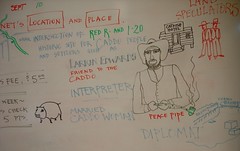As Americans headed West, says caddohistory.com, some people sent their possessions ahead on steamboats up the Red River. The families traveled on horseback or in wagons, frequently traversing this area because it was higher ground. This was known as the Texas Trail numerous years before Shreveport was founded.
James Huntington Cane and William Smith Bennett opened a store in a one-room cabin about 1832 and called it “Cane’s & Bennett’s Bluff.”
Saloons, gambling houses, and dance halls appeared on Commerce Street, giving entertainment to those who had arrived here in the course of moving westward. 2
When the Caddo Indians sold their land to the United States in 1835, they gave a section of the land to their friend and interpreter, Larkin Edwards, who had arrived from Tennessee at the time of the Louisiana Purchase. 3
Edwards sold the land in that same year to Angus McNeill, who located a claim where Shreveport was built. McNeill along with Cane, Bennett, Thomas Taylor Williamson of Arkansas, Sturgis Sprague from Mississippi, Bushrod Jenkins from Natchitoches Parish, James Belton Pickett from South Carolina, and Henry Miller Shreve from Pennsylvania were the founders of the Shreve Town Company on May 27, 1836. 4 These seven investors established the town and invited Shreve to plat it (lay out officially measured sections).
Your teacher has pointed out that in fact they were land speculators; their investment was a gamble.
It was born “Shreve’s Town” and renamed “Shreveport” in 1839. 6 This was the second city in Louisiana, planned because of the fertility of the land and the location along the Red River after it was opened. 7 They formed a community measuring eight streets long and eight wide with the Public Square on Block 23.8 These streets now form present-day downtown Shreveport.
With Texas gaining its independence in 1836, Shreveport’s main street was named Texas Trail and renamed Texas Avenue after its extension. Caddo Street was named for the Caddo Indians, who first owned the land, and Cotton bears the name of the area’s staple crop. Hopeful names were given to Commerce and Market Streets, as the founders anticipated their development into prosperous business streets; the first market house also stood at the northwest intersection of Texas and Market Streets. Fannin, Travis, Milam, and Crockett Streets honor those who died at Goliad, the Alamo, and San Jacinto. Edwards Street remembers Caddo Indian interpreter Larkin Edwards, McNeill Street bears the name of the Shreve Town Company’s president. Spring Street called to mind the nearby springs,
which gave water to the cattle and pasture of the owner of a nearby pioneer boarding house. Lake Street was fittingly named, as it was interrupted by Silver Lake. 9
Shreveport had been challenged by another rising community, Coates Bluff, which had opened the first area post office on April 10, 1838. 10 The community, located on what is now Stoner Hill, had begun with a trading post owned by McLeod and Carr.
Using the Eradicator, Shreve dug a ditch across the forty-two-yard neck of the river circle that went around Coates Bluff, leaving the community dry. 11
skip to main |
skip to sidebar
For students and parents who love education and exploration of the social sciences . . .
Search This Blog
Followers
Blog Archive
-
▼
2010
(346)
-
▼
September
(42)
- Magnet recycling is back, courtesy of pick-up and ...
- Another way to earn Indie points: an essay on a vi...
- The California Map Project - test your peers and f...
- Indie work: integrating the bios of Leo Fender and...
- John Muir, father of the national parks and Sierra...
- Our mission: Be responsible, respectful and seek e...
- Tectonica: last week's quiz and the source of the ...
- California Dreamin: songs about the Golden State
- Topics in the California Project
- A Walk in the Garden: Talent Show on Fri, Sept 24,...
- Getting to know the Pacific rim: California quiz
- The glories of the Golden State, California
- Sustainability: a key term for the coming generations
- A pre-quiz quiz: more tectonics
- The science and medical research that explains the...
- Plates that will crack in a spectacular and nation...
- World geography project: what's inside Spaceship e...
- Indie work - comparison essays
- Pratt Industries: recycling for Shreveport and man...
- Mary Bennett Cane, Shreveport's first important bu...
- Cyberbullying an issue in Upfront magazine: "Techn...
- Demographics, the study of populations
- Guidelines for comparison essays in geography clas...
- Indie work: comparing Henry Miller Shreve and Lark...
- Open notes quiz Tues/Wed: 5 themes of geography an...
- Cochon de lait is the Cajun French term for a pig ...
- Shreveport in Place and Location: the Texas Trail ...
- Syllabus, Magnet geography / Trudeau / 2010-2011
- Quiz #2: Hydrologists & Kinesiologists
- Henry Miller Shreve, the steamer & flat boat and a...
- Coates Bluff Nature Trail, adjacent to Magnet, Sto...
- Mapping overview / East Shreveport; Magnet and nei...
- Reviewing the 5 Themes of Geography
- Stoner Ave at Fant Parkway: Riverscape development...
- Back to school night: Thurs, Sept 9, 5:30 pm
- Class of 2014 Speed Meet on Fri, Sept 10, 6:30 - 8...
- Sketching / mapping the Magnet campus
- Bees at RW Norton Art Foundation, Shreveport; why ...
- Because of the British Empire, we look for this si...
- Indie work (independent): building bonus points an...
- No question that Otzi's an indigenous fellow
- 5 Themes of Geography / Shreveport Bossier
-
▼
September
(42)

